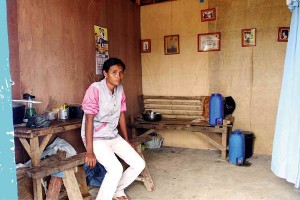
“YOLANDA” victim Jesusa Hiponia tries to make a home out of a bunkhouse unit she occupies with her 11-year-old daughter in Barangay Gogo in Estancia town, Iloilo province. NESTOR P. BURGOS/INQUIRER VISAYAS
Salvacion Medalla and her two children have finally left the on-campus “tent city” that provided temporary shelter for them and other survivors of Supertyphoon “Yolanda” for almost five months.
They moved to a government-built bunkhouse unit in Barangay Gogo, 3.5 kilometers from the town proper, but there was hardly any feeling of excitement from them.
“We want to return to where we used to live, but they won’t allow us. So we have to go there even if it’s too far,” Medalla, 65, told the Philippine Daily Inquirer.
The Medallas and more than 2,000 other residents in the seaside village of Botongon in Estancia town, 153 kilometers northeast of Iloilo City, were evacuated to Northern Iloilo Polytechnic State College West Campus in the town center on Nov. 23 last year following an oil spill triggered by Yolanda.
Double whammy
A 32-megawatt barge operated by National Power Corp. had slammed into the rocky shores of Botongon, spilling at least 900,000 liters of bunker fuel after its hull was damaged. Health authorities had placed the toxicity of air in the community at 15 times above the tolerable level.
The evacuees had stayed in the tents provided by nongovernment organizations.
While some families were allowed to return to Botongon nearly a month after the disaster, Medalla and her children could not do so because the coastline where they used to live had been declared a no-build zone. “My children, who have families already, cannot help me rebuild our house because their houses were also destroyed during the storm,” she said.
Last week, the Medallas and six other families remaining in the tent city were moved to Gogo to join other evacuees in bunkhouses.
Constructed by the Department of Public Works and Highways, the bunkhouses have 120 units, with one family assigned per unit. The floor area has been expanded to 12 feet by 20 feet after humanitarian and relief organizations noted that contractors had not complied with the standard specifications of bunkhouses in Eastern Visayas.
Far from perfect
One of the evacuees, Noel Castro, said the unit was still too small for him, his wife and their six children ages 2 to 16.
VOLUNTEERS from the Jehovah’s Witnesses build a house for a family displaced by Supertyphoon “Yolanda” in Samar province. GOBLETH MOULIC
The bunkhouses are also far from the town center, Castro said. Motorcycles are the only means of public transport, which are rented for P15 per passenger.
“A two-way fare of P30 per person is too much for us when we are having difficulty finding means to buy food,” Castro said.
He and his wife had been engaged in buying and selling dried fish before the storm destroyed many fishing boats. “We have to start all over again,” he said.
The dirt road leading to the bunkhouses becomes dusty when dry and muddy when it rains.
A former Estancia councilor, Wilson Balingit, who is now a convener of Task Force Buliganay that includes survivors and humanitarian groups, said food and housing assistance was still needed nearly six months since the typhoon.
Many have not rebuilt nor repaired their houses, blaming the national government for the lack of assistance. President Aquino’s point man for rehabilitation, Panfilo Lacson, had earlier said the master plan for rehabilitation and recovery had not yet been approved and implemented because some provinces had failed to immediately submit postdamage needs assessments as required by law.
Better choice
Some survivors staying in the Gogo bunkhouses are thankful that they have roofs over their heads. But still, they said their return to their village or somewhere near the town center would be a better choice.
Jesusa Hiponia, 32, who is occupying a unit with her 11-year-old daughter, said the place could get very hot during the day. Although roofed with galvanized iron sheets, the units have no ceiling.
Moreover, there is little privacy because the plywood walls and partitions are open at the top.
A single generator set supplies electricity from 6 p.m. to midnight.
Water is delivered by tanks facilitated by the municipal government. “The water supply is still enough, but we don’t know if it will be that way when all the bunkhouses are filled up,” Hiponia said.
The survivors do not know until when they can stay at the bunkhouses. They, however, hope it will be only for a short time and that the government can provide them with a better relocation site.